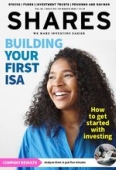Archived article
Please note that tax, investment, pension and ISA rules can change and the information and any views contained in this article may now be inaccurate.
How I invest: a classic investment approach has helped Chris build a big pot

This week’s case study involves Chris, who is in his early 50s and has been investing ‘seriously’ for the last 20 years or so.
Chris takes what you might call a ‘classic’ approach to investing, with a large core of dividend-paying stocks in his SIPP (self-invested personal pension), which he lets compound by re-investing his dividends, and a clutch of more racy stocks in his ISA (individual savings account).
‘It might seem like the perfect approach, but it’s actually the end product of years of taking risks and making mistakes’, he smiles.
HOW HE GOT STARTED
His interest in stocks was first fired by the government privatisations of firms like British Gas (now part of Centrica (CNA)) and British Telecom (now BT Group (BT.)) in the mid-1980s.
‘My dad applied for shares for the whole family and suddenly I owned a piece of these companies, so I set about finding out about them’.
An avid reader, Chris followed the ‘City pages’ in the newspapers and built his knowledge while at university.
His first job after university was in Asia, where he spent the early part of his career, and it was during the frenzy around tech stocks in the late 1990s that he says he learnt some of the most important lessons in investing.
‘More than once I bought into the fantastic stories these companies were peddling, and along with everyone else I got carried away with my hopes’.
Fortunately, he wasn’t investing a lot, but seeing some of his holdings go to zero was still a salutary experience.
‘I decided from that point on I would focus on the reality of what companies were actually doing, rather than just listen to what they said they were doing’.
After returning from Asia, Chris took up a university post which came with a small defined benefit pension scheme as part of his package.
A few years later, when he took the leap from academia and started working for himself, he realised his pension was going to be nowhere near enough to fund a comfortable lifestyle later on.
STARTING TO INVEST SERIOUSLY
It was at this point he began to invest seriously, putting into practice what he had learned from his reading and his personal experience.
In the intervening 20 years he has built up a sizeable pot of what he calls ‘safe and boring’ UK and US stocks, whose job is to generate a steady flow of dividend income, which he reinvests and lets grow by itself.
He also has a smaller pot of ‘thematic’ stocks which align with the big trends he sees playing out over the long term.
‘I buy individual growth shares based on my research and understanding of long-term trends or themes such as healthcare, agribusiness, new technology, China and so on.’
Interestingly, Chris only invests in stocks not in funds or trusts because he wants to keep costs down.
‘I do my own research and I buy the stocks I want to own, whereas with a fund I’m paying someone else to buy stocks and the cost of that is coming out of my returns,’ he says.
STAYING INFORMED
In terms of keeping up with corporate news, Chris still reads the business pages of the newspapers, in particular the Financial Times, as well as using sources like Shares to research his stocks.
One innovation which he is tempted by is the proliferation of low-cost ETFs (exchange-traded funds).
‘I looked at ETFs years ago and the costs weren’t that much different to funds to start with, whereas now they are really competitive.
‘While hindsight is a wonderful thing, if I had the chance to start again, and based on my own experience, having made mistakes and learned from others, I would probably opt to build a ‘core’/’satellite’ portfolio.’
Instead of owning individual stocks, Chris likes the idea of building a core of ETFs from providers like US firm Vanguard, which he can feed every month and leave to grow, while keeping his portfolio of more growth-oriented stocks with the addition of names such as ASML (ASML:AMS), EssilorLuxottica (EL:EPA), Microsoft (MSFT:NASDAQ) and Walt Disney (DIS:NYSE).
He also has a different approach to the idea of retirement, which technically isn’t that far away for him.
NO PLANS TO RETIRE ANY TIME SOON
‘I’m 52, so in theory I could retire at 55 but I think that mind-set is completely outdated these days. I intend to keep working and contributing to my pension pot as long as possible.’
He has just finished reading ‘The 100-Year Life’, written by London Business School professor Lynda Gratton, which suggests the traditional school-work-retirement model is changing as life expectancy rises and final-salary pensions disappear.
‘The way we live and work is changing so much, I can see people having multiple careers and not simply downing tools at 60,’ says Chris.
DISCLAIMER: Please note, we do not provide financial advice in case study articles, and we are unable to comment on the suitability of the subject’s investments. Individuals who are unsure about the suitability of investments should consult a suitably qualified financial adviser. Past performance is not a guide to future performance and some investments need to be held for the long term. Tax treatment depends on your individual circumstances and rules may change. ISA and pension rules apply.
Important information:
These articles are provided by Shares magazine which is published by AJ Bell Media, a part of AJ Bell. Shares is not written by AJ Bell.
Shares is provided for your general information and use and is not a personal recommendation to invest. It is not intended to be relied upon by you in making or not making any investment decisions. The investments referred to in these articles will not be suitable for all investors. If in doubt please seek appropriate independent financial advice.
Investors acting on the information in these articles do so at their own risk and AJ Bell Media and its staff do not accept liability for losses suffered by investors as a result of their investment decisions.
Issue contents
Case study
Editor's View
Feature
Great Ideas
News
- Autodesk stock tanks on margin and free cash flow guidance, wiping out 2023 gains
- Why Telecom Plus shares are down 30% since the start of December
- Find out why the Fed's preferred inflation measure upset markets
- Latest letter from Buffett underlines importance of owning great businesses
- Pets at Home has investors purring with 37% share price rally

 magazine
magazine








